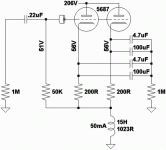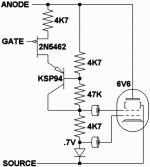A simple follower with both halves of the tube in parallel would
also give an incredibly low output impedance. Do insure that
you bias the tubes (as in the cathodyne) up off the lower rail.
That you have some headroom down there to play with.
Or your cathode choke could swing negative to provide same.
WCF seems to require a few too many under-explained fudge
factors for me to trust it yet. Its not a circuit I'm likely to build
on blind faith that "some guy with a page" did all the math for
me correctly. Though I happen to read that page a lot.
also give an incredibly low output impedance. Do insure that
you bias the tubes (as in the cathodyne) up off the lower rail.
That you have some headroom down there to play with.
Or your cathode choke could swing negative to provide same.
WCF seems to require a few too many under-explained fudge
factors for me to trust it yet. Its not a circuit I'm likely to build
on blind faith that "some guy with a page" did all the math for
me correctly. Though I happen to read that page a lot.
kenpeter said:A simple follower with both halves of the tube in parallel would
also give an incredibly low output impedance. Do insure that
you bias the tubes (as in the cathodyne) up off the lower rail.
That you have some headroom down there to play with.
Or your cathode choke could swing negative to provide same.
WCF seems to require a few too many under-explained fudge
factors for me to trust it yet. Its not a circuit I'm likely to build
on blind faith that "some guy with a page" did all the math for
me correctly. Though I happen to read that page a lot.
Hi Ken,
I think you will find the White CF adequately explained (mathematically) in the pages of old engineering textbooks. I would start with Terman. (I'll look in my copy.) You might also want to google for the original patent submission as I believe this topology was patented. (I could be mistaken.) This was a very commonly used topology where high currents and relatively low output Z are required. (Power consuming load.) No leap of faith is really required..
These days I generally use transformers to drive low Z loads... Works and sounds a lot better than you would expect, particularly in anti-transformer circles.
Actually building the thing and experimenting with it is the best way to find out the math is not always correct, and it strikes me that with your mathematical ability you might just be able to write an equation that better approximates the behavior of the circuit than JB or a lot of other people who have already tried it. Don't be afraid to get your feet wet, there's lots of room for empiricism followed by math to explain what you observed. In the end you'll spend a couple of hours with a few simple pieces of lab equipment, some well thought out experiments, and a lab notebook or excel to record the results.
With 50mA of pull down current sourced from ground at the
quiescent state, seems rather unlikely any load would cry
out for an active current source that could pull down harder.
Yes, you can't drive a load as low as the 43R "impedance"
and expect that 50mA is going to allow much voltage swing.
But any load 100 ohms or higher should permit 5V of swing
as required by the CD player in the original statement. Wait,
thats only the pull down swing! Perhaps we could drive as
low as 50 ohms?
No, wait, thats not right either. Half gets wasted in the amp
if the impedances are too closely matched. Now I have gone
and confused myself again.
quiescent state, seems rather unlikely any load would cry
out for an active current source that could pull down harder.
Yes, you can't drive a load as low as the 43R "impedance"
and expect that 50mA is going to allow much voltage swing.
But any load 100 ohms or higher should permit 5V of swing
as required by the CD player in the original statement. Wait,
thats only the pull down swing! Perhaps we could drive as
low as 50 ohms?
No, wait, thats not right either. Half gets wasted in the amp
if the impedances are too closely matched. Now I have gone
and confused myself again.
kenpeter said:With 50mA of pull down current sourced from ground at the
quiescent state, seems rather unlikely any load would cry
out for an active current source that could pull down harder.
Yes, you can't drive a load as low as the 43R "impedance"
and expect that 50mA is going to allow much voltage swing.
But any load 100 ohms or higher should permit 5V of swing
as required by the CD player in the original statement. Wait,
thats only the pull down swing! Perhaps we could drive as
low as 50 ohms?
No, wait, thats not right either. Half gets wasted in the amp
if the impedances are too closely matched. Now I have gone
and confused myself again.
Welcome to the club, and now I am just as confused too...
Anyway it can drive a real low impedance..
kevinkr said:All of these topologies do suffer from the fact that there is no such thing as a complementary vacuum tube.
No, but if you hum a few bars maybe I can fake it.
This might work better (more triodish) with an
enhancement FET than a screen driven Pentode.
But I'm not chancin to draw any schematic here
without gratuitous tubage grafted on for show.
Not really a compliment to any specific triode.
Perhaps an insult to all triodes as a species?
Whatever... Its P-Channel for sure...
Attachments
- Status
- This old topic is closed. If you want to reopen this topic, contact a moderator using the "Report Post" button.

